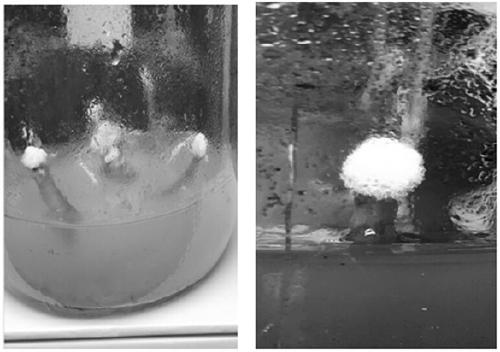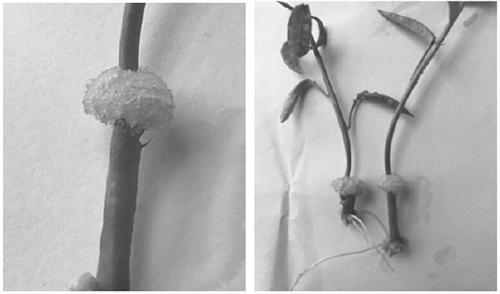Method for inducing differentiation and seedling formation of passion fruit stem section callus
A technology for callus induction and passion fruit, applied in the field of plant cultivation, can solve the problems of few patent documents of passion fruit, no reports in analysis and research, and solve the problems of uneven quality of seedlings, high planting survival rate, and high growth rate. quick effect
- Summary
- Abstract
- Description
- Claims
- Application Information
AI Technical Summary
Problems solved by technology
Method used
Image
Examples
Embodiment 1
[0021] (1) Collection and disinfection of explants: use mature passion fruit stems as explants, select new shoots of vigorously growing and disease-free plants, wash the surface of tap water, soak in 1wt.% sodium hypochlorite solution for 15 min, and rinse with tap water Rinse well, sterilize in 75% alcohol by volume for 10 seconds, then sterilize with 0.1wt.% mercuric chloride for 5 minutes, and rinse with sterile water for 4 times;
[0022] (2) Induction culture: Under sterile conditions, the sterilized branches were cut into 1.2 cm stem segments and inserted upright into the induction medium. The light was continuously illuminated for 8 h every day, and the light intensity was 1200 lx. The culture temperature was 27 °C during the day and 21°C, cultivate for 130 days;
[0023] (3) Subculture; the seedlings formed on the induction medium were cut into stems with buds under aseptic conditions and transplanted into the growth medium, with continuous light for 12 h every day, li...
Embodiment 2
[0029] (1) Collection and disinfection of explants: use mature passion fruit stems as explants, select new shoots of vigorously growing and disease-free plants, wash the surface of tap water, soak in 1wt.% sodium hypochlorite solution for 15 min, and rinse with tap water Rinse well, sterilize in 75% alcohol by volume for 10 seconds, then sterilize with 0.1wt.% mercuric chloride for 6 minutes, and rinse with sterile water for 5 times;
[0030] (2) Induction culture: Cut the sterilized shoots into 1.3 cm stems and insert them upright into the induction medium under sterile conditions, continuously light for 8 hours a day, light intensity 1000 lx, culture temperature 21-27 ℃, cultivate 130 days;
[0031] (3) Subculture; the seedlings formed on the induction medium were cut into stems with buds under aseptic conditions and transplanted into the growth medium, with continuous light for 12 h every day, light intensity of 2 000 lx, and culture temperature of 25± 1 ℃, cultivated for ...
Embodiment 3
[0038] (1) Collection and disinfection of explants: use mature passion fruit stems as explants, select new shoots of vigorously growing and disease-free plants, wash the surface of tap water, soak in 1wt.% sodium hypochlorite solution for 15 min, and rinse with tap water Rinse well, sterilize in 75% alcohol by volume for 10 seconds, then sterilize with 0.1wt.% mercuric chloride for 6 minutes, and rinse 4 times with sterile water;
[0039] (2) Induction culture: Under sterile conditions, cut the sterilized branches into 1.3 cm stems and insert them upright into the induction medium, with continuous light for 8 hours a day, light intensity of 1500 lx, and culture temperature of 21-27 °C. 130 days;
[0040](3) Subculture; the seedlings formed on the induction medium were cut into stems with buds under aseptic conditions and transplanted into the growth medium, with continuous light for 12 h every day, light intensity of 2500 lx, and culture temperature of 25±1 ℃, cultivated for ...
PUM
 Login to View More
Login to View More Abstract
Description
Claims
Application Information
 Login to View More
Login to View More - R&D
- Intellectual Property
- Life Sciences
- Materials
- Tech Scout
- Unparalleled Data Quality
- Higher Quality Content
- 60% Fewer Hallucinations
Browse by: Latest US Patents, China's latest patents, Technical Efficacy Thesaurus, Application Domain, Technology Topic, Popular Technical Reports.
© 2025 PatSnap. All rights reserved.Legal|Privacy policy|Modern Slavery Act Transparency Statement|Sitemap|About US| Contact US: help@patsnap.com



